Developing Leadership Skills in Culturally Diverse Teams Report
VerifiedAdded on 2020/04/13
|11
|2551
|204
Report
AI Summary
This report examines the challenges and strategies of leadership in culturally diverse teams. The author, drawing from personal experience, addresses issues such as language barriers, cultural stereotypes, and biases within a team setting. The report highlights the importance of intercultural knowledge, mindfulness, and skills in fostering effective communication and teamwork. The author details the implementation of training sessions and feedback mechanisms to promote cultural sensitivity and understanding. Furthermore, the report applies Belbin's theory of leadership roles to explain the author's approach to conflict resolution and team management, emphasizing the roles of specialist, monitor evaluator, coordinator, plant, resource investigator, team worker, shaper, implementer, and finisher. The conclusion underscores the significance of these strategies in overcoming cultural challenges and building cohesive, productive teams.
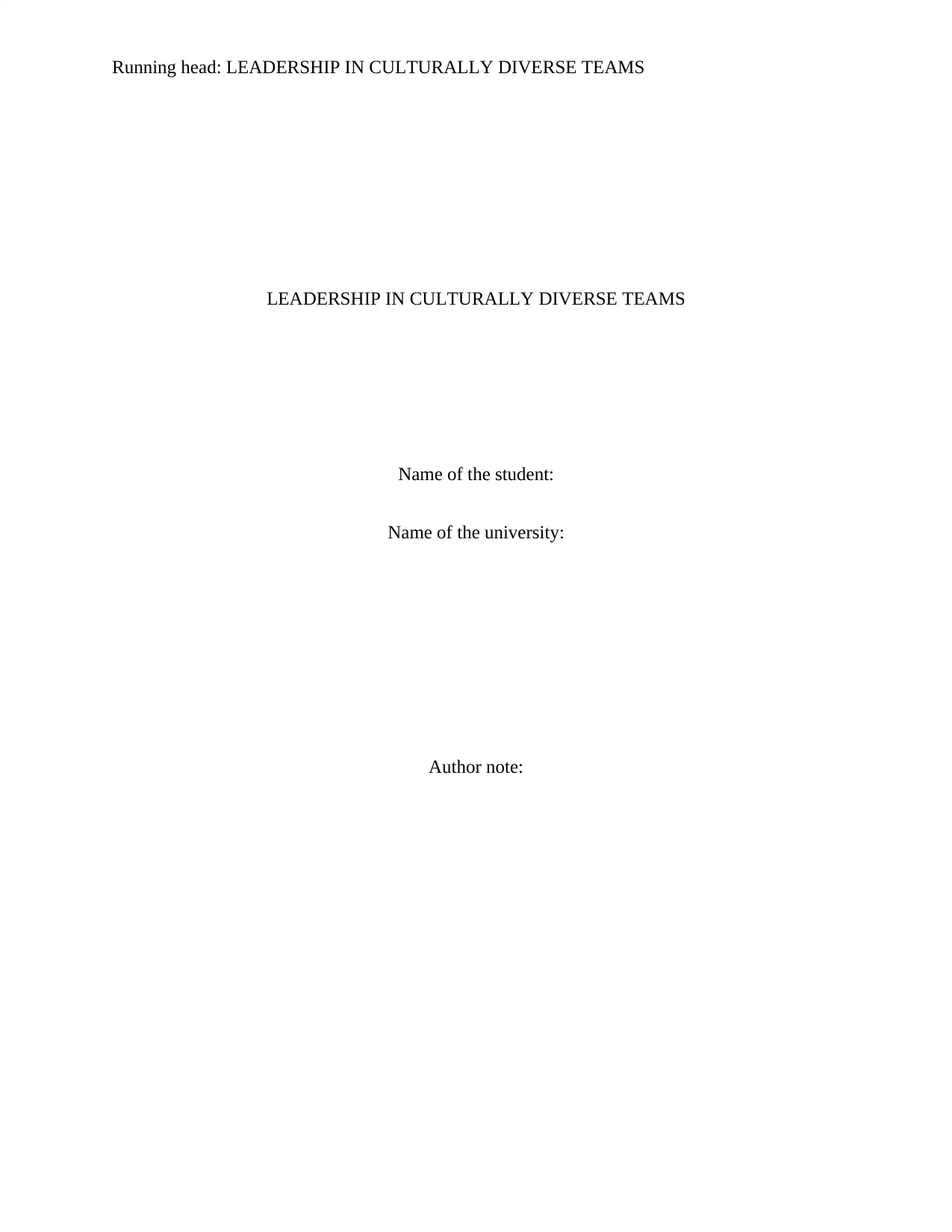
Running head: LEADERSHIP IN CULTURALLY DIVERSE TEAMS
LEADERSHIP IN CULTURALLY DIVERSE TEAMS
Name of the student:
Name of the university:
Author note:
LEADERSHIP IN CULTURALLY DIVERSE TEAMS
Name of the student:
Name of the university:
Author note:
Paraphrase This Document
Need a fresh take? Get an instant paraphrase of this document with our AI Paraphraser
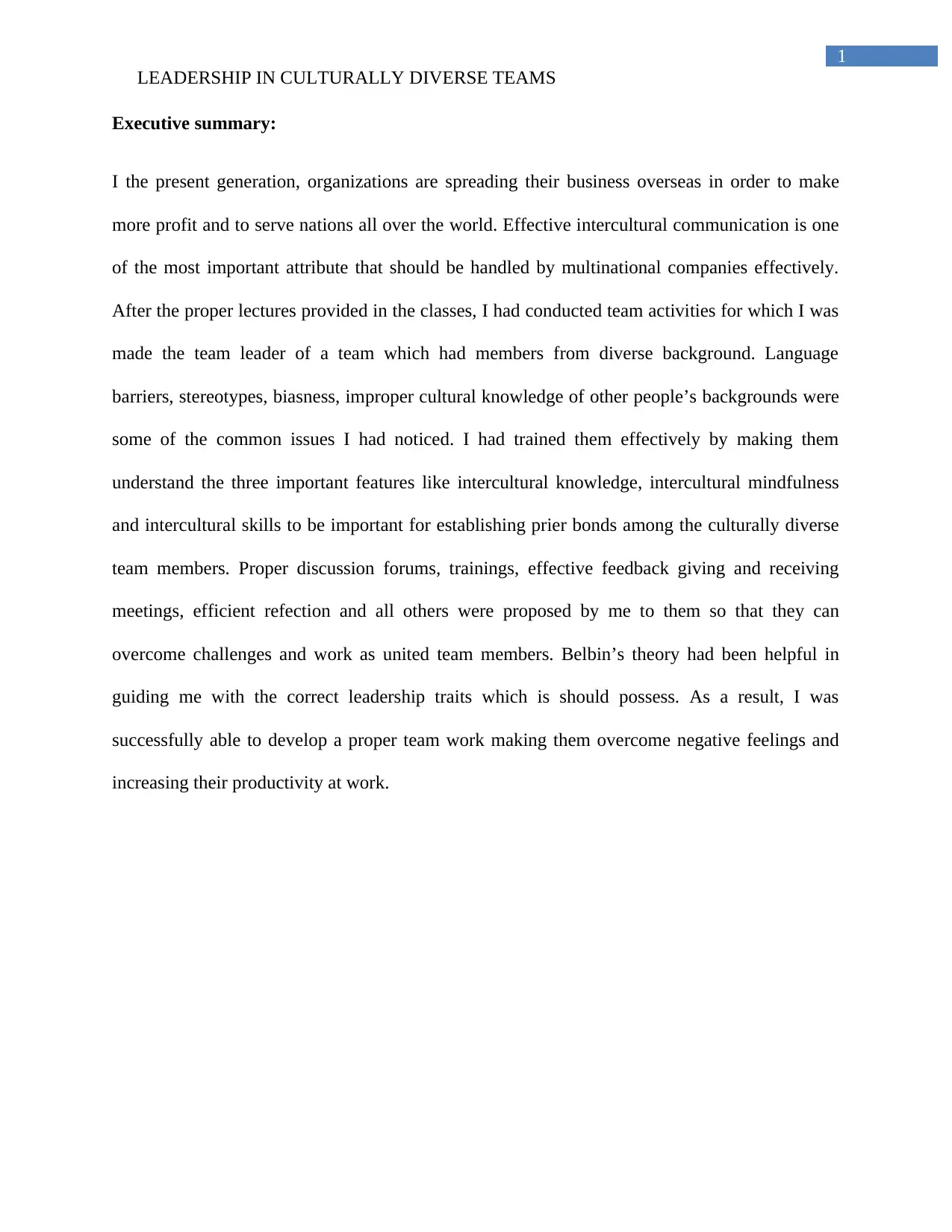
1
LEADERSHIP IN CULTURALLY DIVERSE TEAMS
Executive summary:
I the present generation, organizations are spreading their business overseas in order to make
more profit and to serve nations all over the world. Effective intercultural communication is one
of the most important attribute that should be handled by multinational companies effectively.
After the proper lectures provided in the classes, I had conducted team activities for which I was
made the team leader of a team which had members from diverse background. Language
barriers, stereotypes, biasness, improper cultural knowledge of other people’s backgrounds were
some of the common issues I had noticed. I had trained them effectively by making them
understand the three important features like intercultural knowledge, intercultural mindfulness
and intercultural skills to be important for establishing prier bonds among the culturally diverse
team members. Proper discussion forums, trainings, effective feedback giving and receiving
meetings, efficient refection and all others were proposed by me to them so that they can
overcome challenges and work as united team members. Belbin’s theory had been helpful in
guiding me with the correct leadership traits which is should possess. As a result, I was
successfully able to develop a proper team work making them overcome negative feelings and
increasing their productivity at work.
LEADERSHIP IN CULTURALLY DIVERSE TEAMS
Executive summary:
I the present generation, organizations are spreading their business overseas in order to make
more profit and to serve nations all over the world. Effective intercultural communication is one
of the most important attribute that should be handled by multinational companies effectively.
After the proper lectures provided in the classes, I had conducted team activities for which I was
made the team leader of a team which had members from diverse background. Language
barriers, stereotypes, biasness, improper cultural knowledge of other people’s backgrounds were
some of the common issues I had noticed. I had trained them effectively by making them
understand the three important features like intercultural knowledge, intercultural mindfulness
and intercultural skills to be important for establishing prier bonds among the culturally diverse
team members. Proper discussion forums, trainings, effective feedback giving and receiving
meetings, efficient refection and all others were proposed by me to them so that they can
overcome challenges and work as united team members. Belbin’s theory had been helpful in
guiding me with the correct leadership traits which is should possess. As a result, I was
successfully able to develop a proper team work making them overcome negative feelings and
increasing their productivity at work.
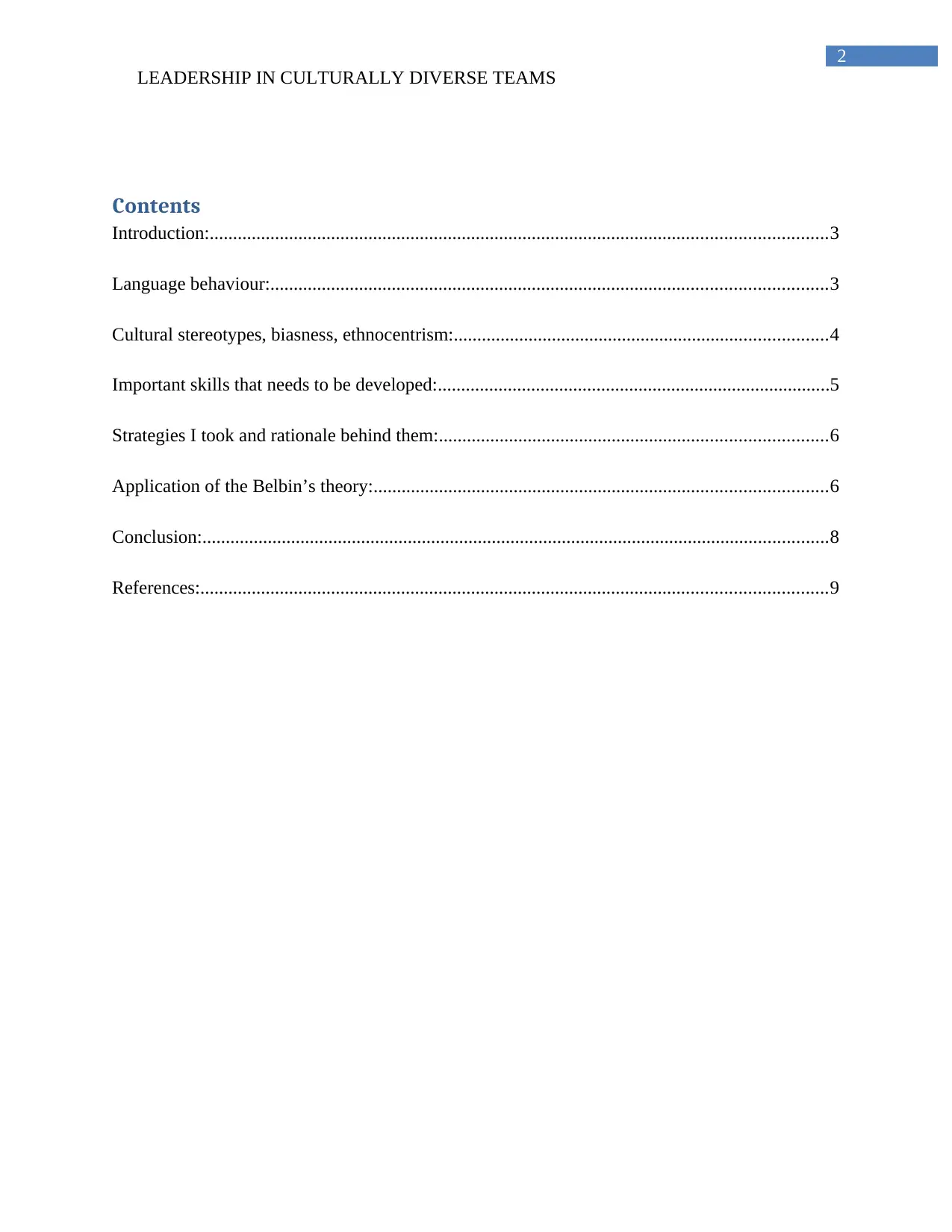
2
LEADERSHIP IN CULTURALLY DIVERSE TEAMS
Contents
Introduction:....................................................................................................................................3
Language behaviour:.......................................................................................................................3
Cultural stereotypes, biasness, ethnocentrism:................................................................................4
Important skills that needs to be developed:....................................................................................5
Strategies I took and rationale behind them:...................................................................................6
Application of the Belbin’s theory:.................................................................................................6
Conclusion:......................................................................................................................................8
References:......................................................................................................................................9
LEADERSHIP IN CULTURALLY DIVERSE TEAMS
Contents
Introduction:....................................................................................................................................3
Language behaviour:.......................................................................................................................3
Cultural stereotypes, biasness, ethnocentrism:................................................................................4
Important skills that needs to be developed:....................................................................................5
Strategies I took and rationale behind them:...................................................................................6
Application of the Belbin’s theory:.................................................................................................6
Conclusion:......................................................................................................................................8
References:......................................................................................................................................9
⊘ This is a preview!⊘
Do you want full access?
Subscribe today to unlock all pages.

Trusted by 1+ million students worldwide
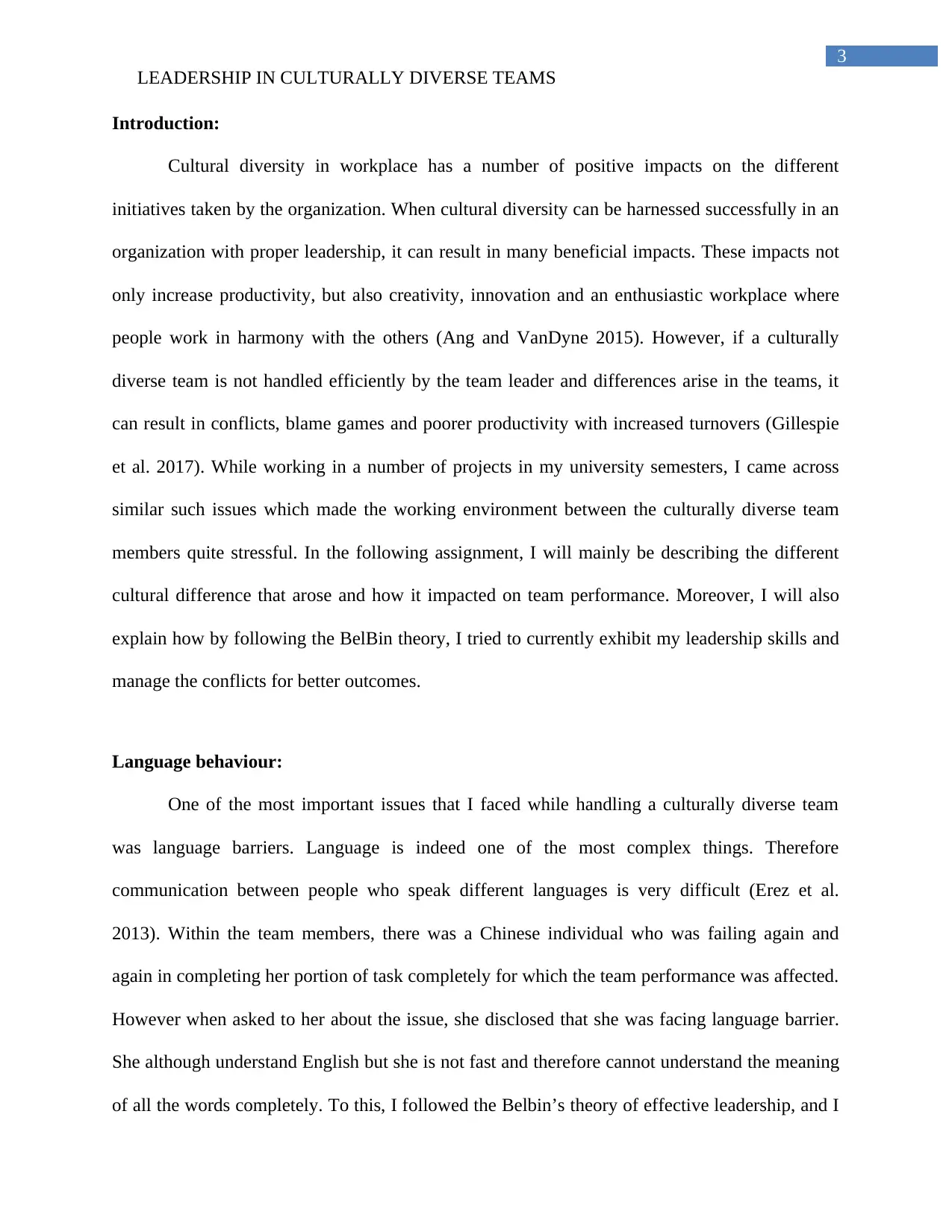
3
LEADERSHIP IN CULTURALLY DIVERSE TEAMS
Introduction:
Cultural diversity in workplace has a number of positive impacts on the different
initiatives taken by the organization. When cultural diversity can be harnessed successfully in an
organization with proper leadership, it can result in many beneficial impacts. These impacts not
only increase productivity, but also creativity, innovation and an enthusiastic workplace where
people work in harmony with the others (Ang and VanDyne 2015). However, if a culturally
diverse team is not handled efficiently by the team leader and differences arise in the teams, it
can result in conflicts, blame games and poorer productivity with increased turnovers (Gillespie
et al. 2017). While working in a number of projects in my university semesters, I came across
similar such issues which made the working environment between the culturally diverse team
members quite stressful. In the following assignment, I will mainly be describing the different
cultural difference that arose and how it impacted on team performance. Moreover, I will also
explain how by following the BelBin theory, I tried to currently exhibit my leadership skills and
manage the conflicts for better outcomes.
Language behaviour:
One of the most important issues that I faced while handling a culturally diverse team
was language barriers. Language is indeed one of the most complex things. Therefore
communication between people who speak different languages is very difficult (Erez et al.
2013). Within the team members, there was a Chinese individual who was failing again and
again in completing her portion of task completely for which the team performance was affected.
However when asked to her about the issue, she disclosed that she was facing language barrier.
She although understand English but she is not fast and therefore cannot understand the meaning
of all the words completely. To this, I followed the Belbin’s theory of effective leadership, and I
LEADERSHIP IN CULTURALLY DIVERSE TEAMS
Introduction:
Cultural diversity in workplace has a number of positive impacts on the different
initiatives taken by the organization. When cultural diversity can be harnessed successfully in an
organization with proper leadership, it can result in many beneficial impacts. These impacts not
only increase productivity, but also creativity, innovation and an enthusiastic workplace where
people work in harmony with the others (Ang and VanDyne 2015). However, if a culturally
diverse team is not handled efficiently by the team leader and differences arise in the teams, it
can result in conflicts, blame games and poorer productivity with increased turnovers (Gillespie
et al. 2017). While working in a number of projects in my university semesters, I came across
similar such issues which made the working environment between the culturally diverse team
members quite stressful. In the following assignment, I will mainly be describing the different
cultural difference that arose and how it impacted on team performance. Moreover, I will also
explain how by following the BelBin theory, I tried to currently exhibit my leadership skills and
manage the conflicts for better outcomes.
Language behaviour:
One of the most important issues that I faced while handling a culturally diverse team
was language barriers. Language is indeed one of the most complex things. Therefore
communication between people who speak different languages is very difficult (Erez et al.
2013). Within the team members, there was a Chinese individual who was failing again and
again in completing her portion of task completely for which the team performance was affected.
However when asked to her about the issue, she disclosed that she was facing language barrier.
She although understand English but she is not fast and therefore cannot understand the meaning
of all the words completely. To this, I followed the Belbin’s theory of effective leadership, and I
Paraphrase This Document
Need a fresh take? Get an instant paraphrase of this document with our AI Paraphraser
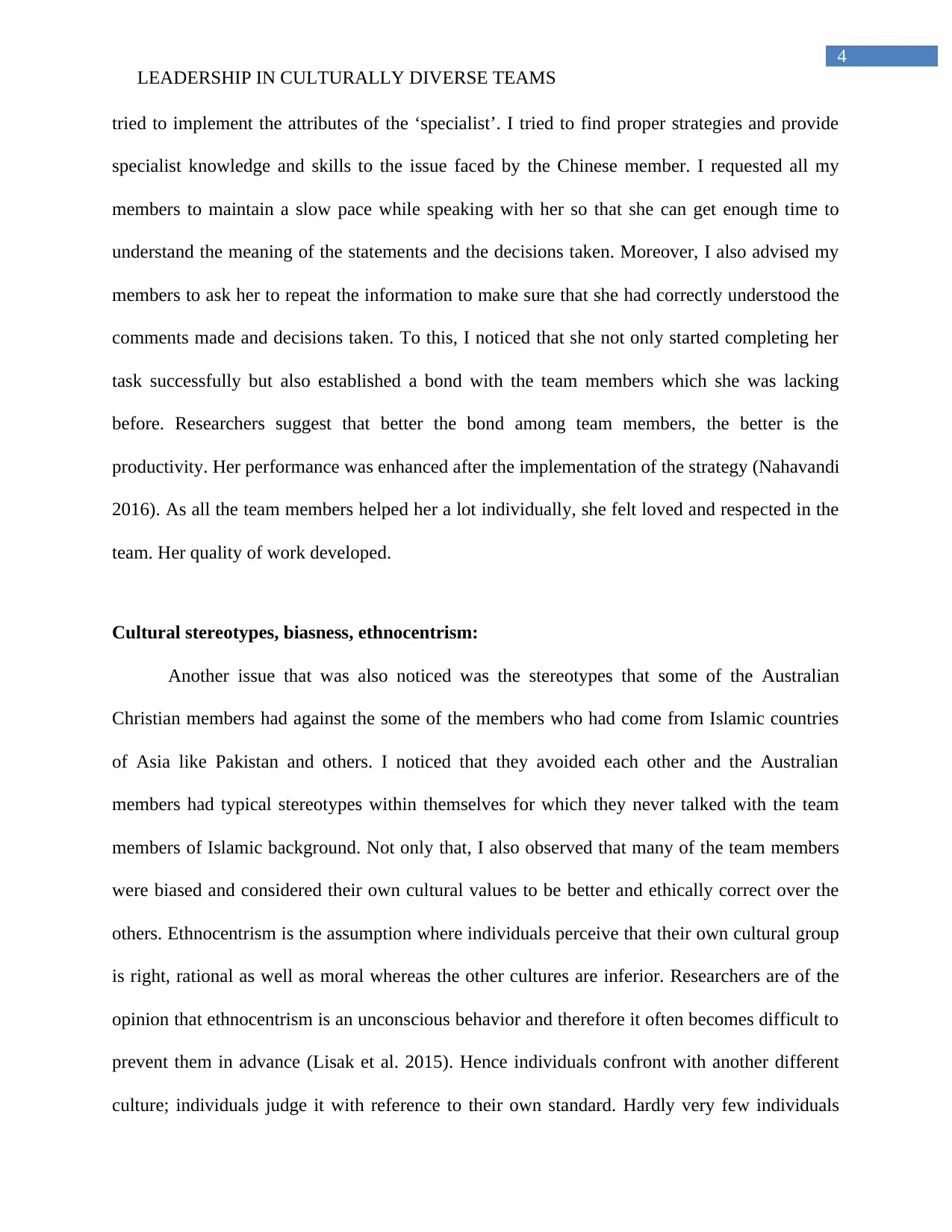
4
LEADERSHIP IN CULTURALLY DIVERSE TEAMS
tried to implement the attributes of the ‘specialist’. I tried to find proper strategies and provide
specialist knowledge and skills to the issue faced by the Chinese member. I requested all my
members to maintain a slow pace while speaking with her so that she can get enough time to
understand the meaning of the statements and the decisions taken. Moreover, I also advised my
members to ask her to repeat the information to make sure that she had correctly understood the
comments made and decisions taken. To this, I noticed that she not only started completing her
task successfully but also established a bond with the team members which she was lacking
before. Researchers suggest that better the bond among team members, the better is the
productivity. Her performance was enhanced after the implementation of the strategy (Nahavandi
2016). As all the team members helped her a lot individually, she felt loved and respected in the
team. Her quality of work developed.
Cultural stereotypes, biasness, ethnocentrism:
Another issue that was also noticed was the stereotypes that some of the Australian
Christian members had against the some of the members who had come from Islamic countries
of Asia like Pakistan and others. I noticed that they avoided each other and the Australian
members had typical stereotypes within themselves for which they never talked with the team
members of Islamic background. Not only that, I also observed that many of the team members
were biased and considered their own cultural values to be better and ethically correct over the
others. Ethnocentrism is the assumption where individuals perceive that their own cultural group
is right, rational as well as moral whereas the other cultures are inferior. Researchers are of the
opinion that ethnocentrism is an unconscious behavior and therefore it often becomes difficult to
prevent them in advance (Lisak et al. 2015). Hence individuals confront with another different
culture; individuals judge it with reference to their own standard. Hardly very few individuals
LEADERSHIP IN CULTURALLY DIVERSE TEAMS
tried to implement the attributes of the ‘specialist’. I tried to find proper strategies and provide
specialist knowledge and skills to the issue faced by the Chinese member. I requested all my
members to maintain a slow pace while speaking with her so that she can get enough time to
understand the meaning of the statements and the decisions taken. Moreover, I also advised my
members to ask her to repeat the information to make sure that she had correctly understood the
comments made and decisions taken. To this, I noticed that she not only started completing her
task successfully but also established a bond with the team members which she was lacking
before. Researchers suggest that better the bond among team members, the better is the
productivity. Her performance was enhanced after the implementation of the strategy (Nahavandi
2016). As all the team members helped her a lot individually, she felt loved and respected in the
team. Her quality of work developed.
Cultural stereotypes, biasness, ethnocentrism:
Another issue that was also noticed was the stereotypes that some of the Australian
Christian members had against the some of the members who had come from Islamic countries
of Asia like Pakistan and others. I noticed that they avoided each other and the Australian
members had typical stereotypes within themselves for which they never talked with the team
members of Islamic background. Not only that, I also observed that many of the team members
were biased and considered their own cultural values to be better and ethically correct over the
others. Ethnocentrism is the assumption where individuals perceive that their own cultural group
is right, rational as well as moral whereas the other cultures are inferior. Researchers are of the
opinion that ethnocentrism is an unconscious behavior and therefore it often becomes difficult to
prevent them in advance (Lisak et al. 2015). Hence individuals confront with another different
culture; individuals judge it with reference to their own standard. Hardly very few individuals
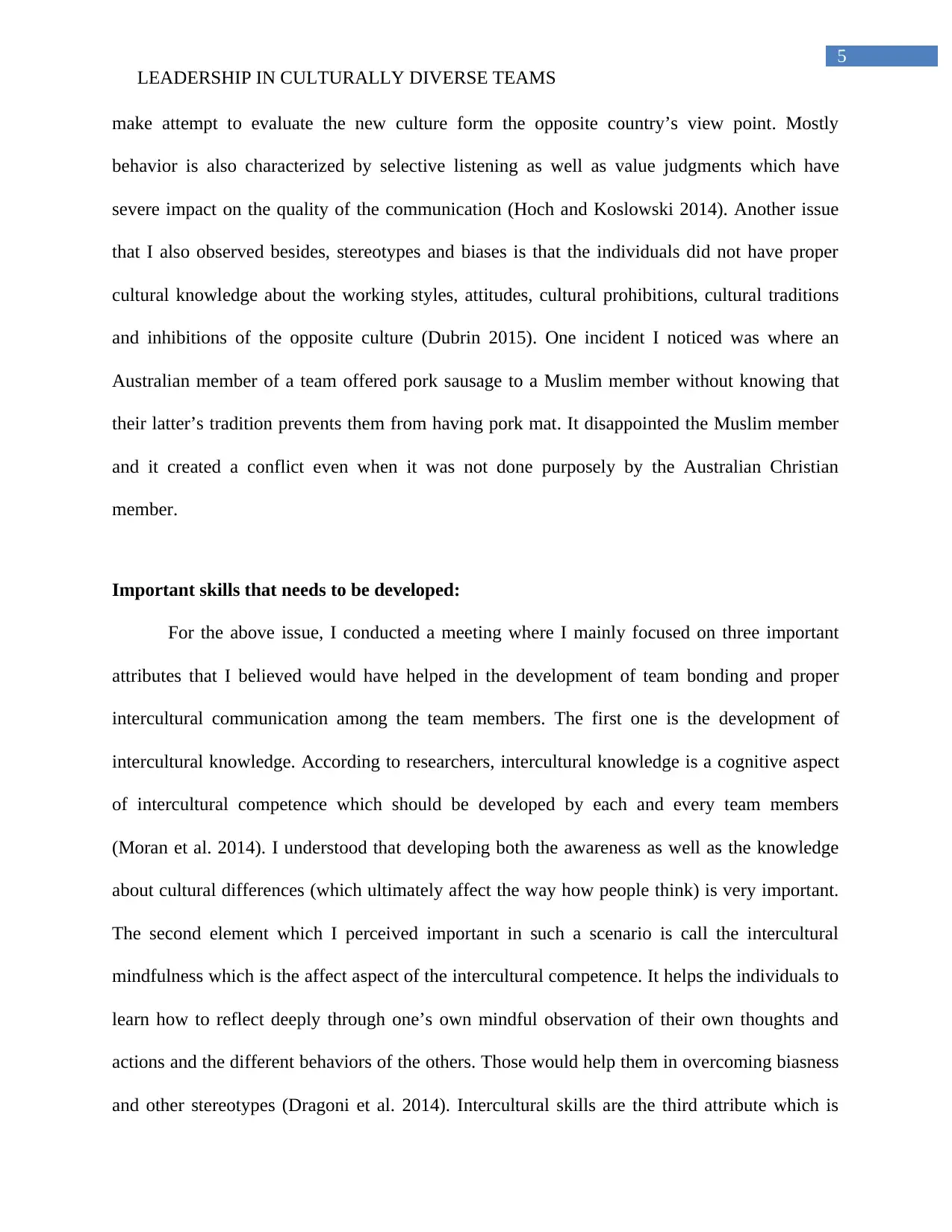
5
LEADERSHIP IN CULTURALLY DIVERSE TEAMS
make attempt to evaluate the new culture form the opposite country’s view point. Mostly
behavior is also characterized by selective listening as well as value judgments which have
severe impact on the quality of the communication (Hoch and Koslowski 2014). Another issue
that I also observed besides, stereotypes and biases is that the individuals did not have proper
cultural knowledge about the working styles, attitudes, cultural prohibitions, cultural traditions
and inhibitions of the opposite culture (Dubrin 2015). One incident I noticed was where an
Australian member of a team offered pork sausage to a Muslim member without knowing that
their latter’s tradition prevents them from having pork mat. It disappointed the Muslim member
and it created a conflict even when it was not done purposely by the Australian Christian
member.
Important skills that needs to be developed:
For the above issue, I conducted a meeting where I mainly focused on three important
attributes that I believed would have helped in the development of team bonding and proper
intercultural communication among the team members. The first one is the development of
intercultural knowledge. According to researchers, intercultural knowledge is a cognitive aspect
of intercultural competence which should be developed by each and every team members
(Moran et al. 2014). I understood that developing both the awareness as well as the knowledge
about cultural differences (which ultimately affect the way how people think) is very important.
The second element which I perceived important in such a scenario is call the intercultural
mindfulness which is the affect aspect of the intercultural competence. It helps the individuals to
learn how to reflect deeply through one’s own mindful observation of their own thoughts and
actions and the different behaviors of the others. Those would help them in overcoming biasness
and other stereotypes (Dragoni et al. 2014). Intercultural skills are the third attribute which is
LEADERSHIP IN CULTURALLY DIVERSE TEAMS
make attempt to evaluate the new culture form the opposite country’s view point. Mostly
behavior is also characterized by selective listening as well as value judgments which have
severe impact on the quality of the communication (Hoch and Koslowski 2014). Another issue
that I also observed besides, stereotypes and biases is that the individuals did not have proper
cultural knowledge about the working styles, attitudes, cultural prohibitions, cultural traditions
and inhibitions of the opposite culture (Dubrin 2015). One incident I noticed was where an
Australian member of a team offered pork sausage to a Muslim member without knowing that
their latter’s tradition prevents them from having pork mat. It disappointed the Muslim member
and it created a conflict even when it was not done purposely by the Australian Christian
member.
Important skills that needs to be developed:
For the above issue, I conducted a meeting where I mainly focused on three important
attributes that I believed would have helped in the development of team bonding and proper
intercultural communication among the team members. The first one is the development of
intercultural knowledge. According to researchers, intercultural knowledge is a cognitive aspect
of intercultural competence which should be developed by each and every team members
(Moran et al. 2014). I understood that developing both the awareness as well as the knowledge
about cultural differences (which ultimately affect the way how people think) is very important.
The second element which I perceived important in such a scenario is call the intercultural
mindfulness which is the affect aspect of the intercultural competence. It helps the individuals to
learn how to reflect deeply through one’s own mindful observation of their own thoughts and
actions and the different behaviors of the others. Those would help them in overcoming biasness
and other stereotypes (Dragoni et al. 2014). Intercultural skills are the third attribute which is
⊘ This is a preview!⊘
Do you want full access?
Subscribe today to unlock all pages.

Trusted by 1+ million students worldwide
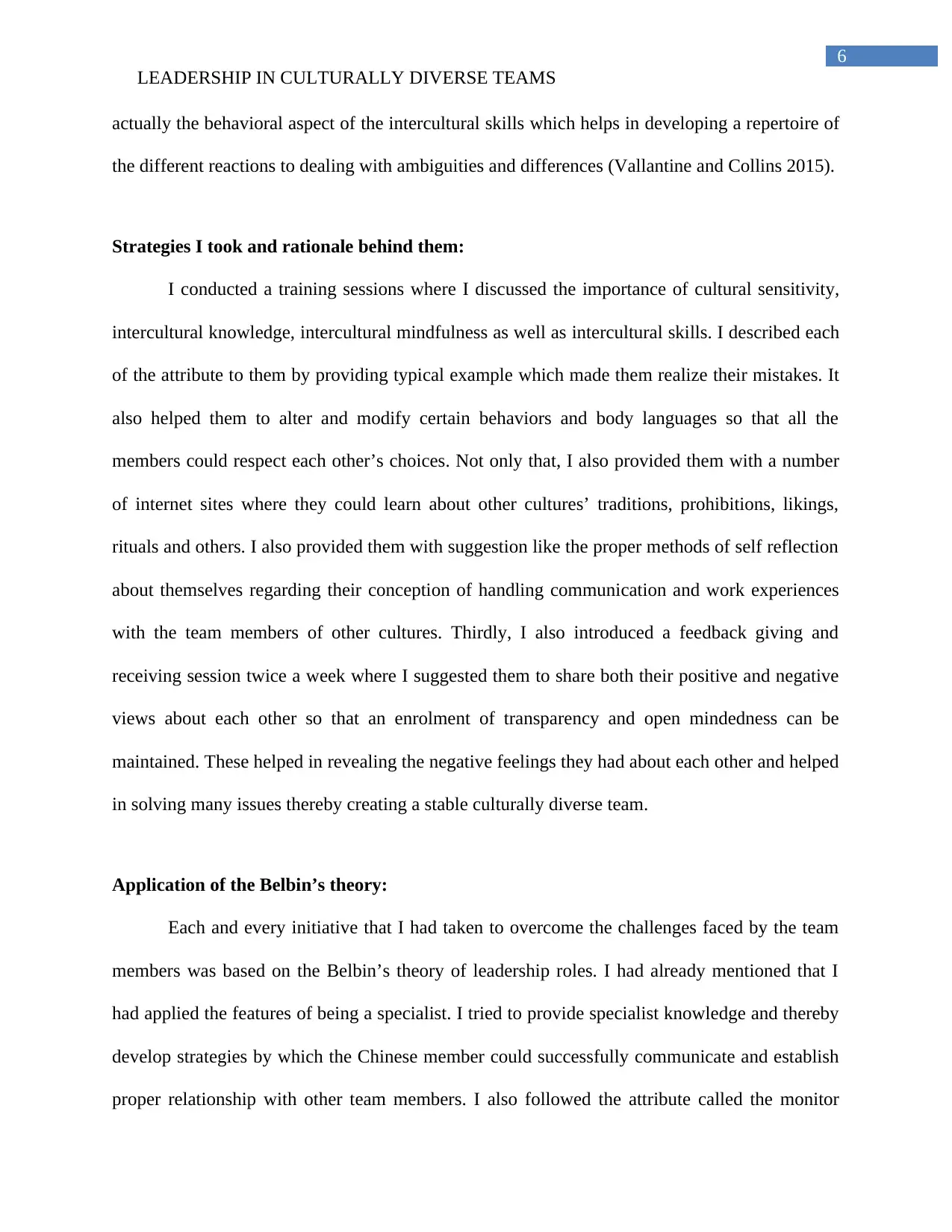
6
LEADERSHIP IN CULTURALLY DIVERSE TEAMS
actually the behavioral aspect of the intercultural skills which helps in developing a repertoire of
the different reactions to dealing with ambiguities and differences (Vallantine and Collins 2015).
Strategies I took and rationale behind them:
I conducted a training sessions where I discussed the importance of cultural sensitivity,
intercultural knowledge, intercultural mindfulness as well as intercultural skills. I described each
of the attribute to them by providing typical example which made them realize their mistakes. It
also helped them to alter and modify certain behaviors and body languages so that all the
members could respect each other’s choices. Not only that, I also provided them with a number
of internet sites where they could learn about other cultures’ traditions, prohibitions, likings,
rituals and others. I also provided them with suggestion like the proper methods of self reflection
about themselves regarding their conception of handling communication and work experiences
with the team members of other cultures. Thirdly, I also introduced a feedback giving and
receiving session twice a week where I suggested them to share both their positive and negative
views about each other so that an enrolment of transparency and open mindedness can be
maintained. These helped in revealing the negative feelings they had about each other and helped
in solving many issues thereby creating a stable culturally diverse team.
Application of the Belbin’s theory:
Each and every initiative that I had taken to overcome the challenges faced by the team
members was based on the Belbin’s theory of leadership roles. I had already mentioned that I
had applied the features of being a specialist. I tried to provide specialist knowledge and thereby
develop strategies by which the Chinese member could successfully communicate and establish
proper relationship with other team members. I also followed the attribute called the monitor
LEADERSHIP IN CULTURALLY DIVERSE TEAMS
actually the behavioral aspect of the intercultural skills which helps in developing a repertoire of
the different reactions to dealing with ambiguities and differences (Vallantine and Collins 2015).
Strategies I took and rationale behind them:
I conducted a training sessions where I discussed the importance of cultural sensitivity,
intercultural knowledge, intercultural mindfulness as well as intercultural skills. I described each
of the attribute to them by providing typical example which made them realize their mistakes. It
also helped them to alter and modify certain behaviors and body languages so that all the
members could respect each other’s choices. Not only that, I also provided them with a number
of internet sites where they could learn about other cultures’ traditions, prohibitions, likings,
rituals and others. I also provided them with suggestion like the proper methods of self reflection
about themselves regarding their conception of handling communication and work experiences
with the team members of other cultures. Thirdly, I also introduced a feedback giving and
receiving session twice a week where I suggested them to share both their positive and negative
views about each other so that an enrolment of transparency and open mindedness can be
maintained. These helped in revealing the negative feelings they had about each other and helped
in solving many issues thereby creating a stable culturally diverse team.
Application of the Belbin’s theory:
Each and every initiative that I had taken to overcome the challenges faced by the team
members was based on the Belbin’s theory of leadership roles. I had already mentioned that I
had applied the features of being a specialist. I tried to provide specialist knowledge and thereby
develop strategies by which the Chinese member could successfully communicate and establish
proper relationship with other team members. I also followed the attribute called the monitor
Paraphrase This Document
Need a fresh take? Get an instant paraphrase of this document with our AI Paraphraser
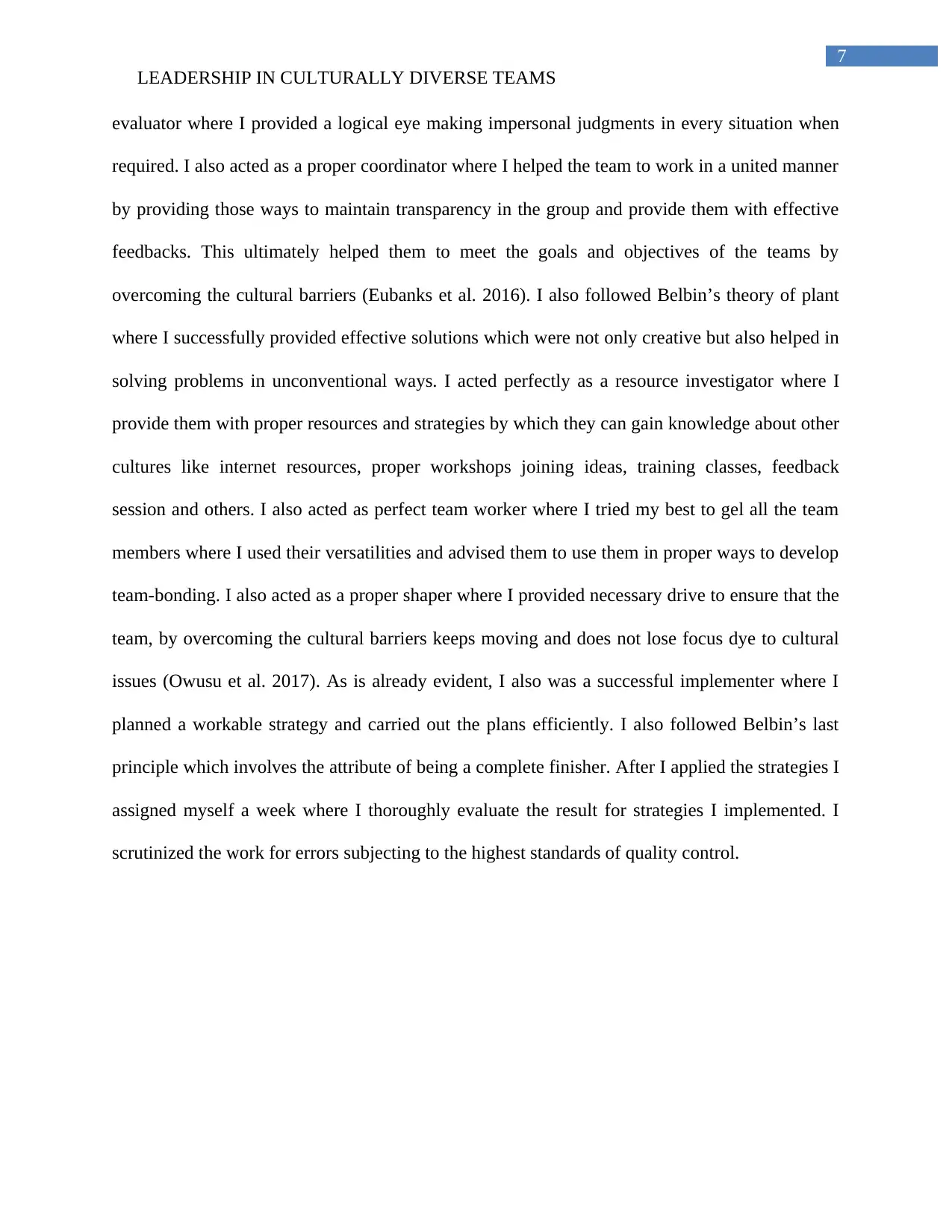
7
LEADERSHIP IN CULTURALLY DIVERSE TEAMS
evaluator where I provided a logical eye making impersonal judgments in every situation when
required. I also acted as a proper coordinator where I helped the team to work in a united manner
by providing those ways to maintain transparency in the group and provide them with effective
feedbacks. This ultimately helped them to meet the goals and objectives of the teams by
overcoming the cultural barriers (Eubanks et al. 2016). I also followed Belbin’s theory of plant
where I successfully provided effective solutions which were not only creative but also helped in
solving problems in unconventional ways. I acted perfectly as a resource investigator where I
provide them with proper resources and strategies by which they can gain knowledge about other
cultures like internet resources, proper workshops joining ideas, training classes, feedback
session and others. I also acted as perfect team worker where I tried my best to gel all the team
members where I used their versatilities and advised them to use them in proper ways to develop
team-bonding. I also acted as a proper shaper where I provided necessary drive to ensure that the
team, by overcoming the cultural barriers keeps moving and does not lose focus dye to cultural
issues (Owusu et al. 2017). As is already evident, I also was a successful implementer where I
planned a workable strategy and carried out the plans efficiently. I also followed Belbin’s last
principle which involves the attribute of being a complete finisher. After I applied the strategies I
assigned myself a week where I thoroughly evaluate the result for strategies I implemented. I
scrutinized the work for errors subjecting to the highest standards of quality control.
LEADERSHIP IN CULTURALLY DIVERSE TEAMS
evaluator where I provided a logical eye making impersonal judgments in every situation when
required. I also acted as a proper coordinator where I helped the team to work in a united manner
by providing those ways to maintain transparency in the group and provide them with effective
feedbacks. This ultimately helped them to meet the goals and objectives of the teams by
overcoming the cultural barriers (Eubanks et al. 2016). I also followed Belbin’s theory of plant
where I successfully provided effective solutions which were not only creative but also helped in
solving problems in unconventional ways. I acted perfectly as a resource investigator where I
provide them with proper resources and strategies by which they can gain knowledge about other
cultures like internet resources, proper workshops joining ideas, training classes, feedback
session and others. I also acted as perfect team worker where I tried my best to gel all the team
members where I used their versatilities and advised them to use them in proper ways to develop
team-bonding. I also acted as a proper shaper where I provided necessary drive to ensure that the
team, by overcoming the cultural barriers keeps moving and does not lose focus dye to cultural
issues (Owusu et al. 2017). As is already evident, I also was a successful implementer where I
planned a workable strategy and carried out the plans efficiently. I also followed Belbin’s last
principle which involves the attribute of being a complete finisher. After I applied the strategies I
assigned myself a week where I thoroughly evaluate the result for strategies I implemented. I
scrutinized the work for errors subjecting to the highest standards of quality control.
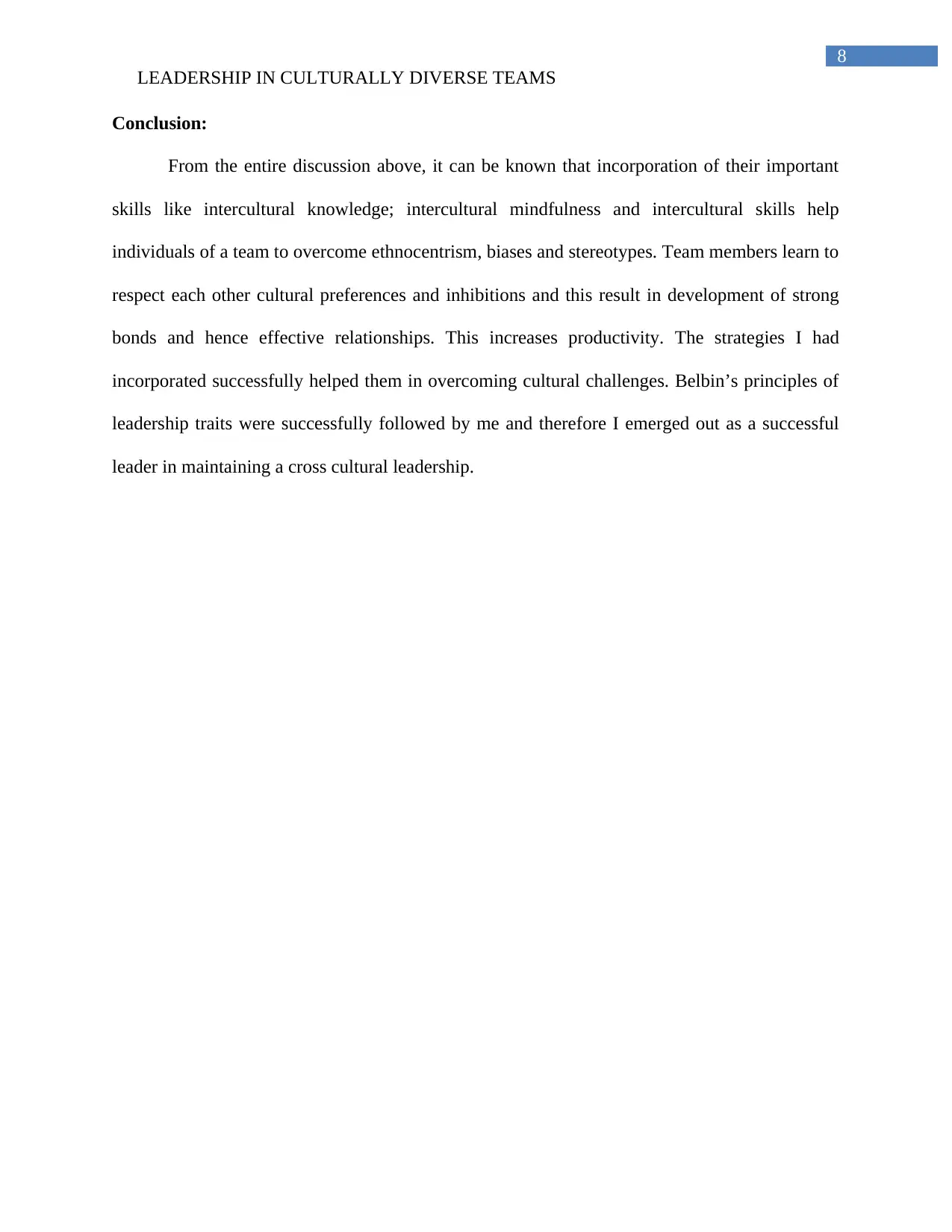
8
LEADERSHIP IN CULTURALLY DIVERSE TEAMS
Conclusion:
From the entire discussion above, it can be known that incorporation of their important
skills like intercultural knowledge; intercultural mindfulness and intercultural skills help
individuals of a team to overcome ethnocentrism, biases and stereotypes. Team members learn to
respect each other cultural preferences and inhibitions and this result in development of strong
bonds and hence effective relationships. This increases productivity. The strategies I had
incorporated successfully helped them in overcoming cultural challenges. Belbin’s principles of
leadership traits were successfully followed by me and therefore I emerged out as a successful
leader in maintaining a cross cultural leadership.
LEADERSHIP IN CULTURALLY DIVERSE TEAMS
Conclusion:
From the entire discussion above, it can be known that incorporation of their important
skills like intercultural knowledge; intercultural mindfulness and intercultural skills help
individuals of a team to overcome ethnocentrism, biases and stereotypes. Team members learn to
respect each other cultural preferences and inhibitions and this result in development of strong
bonds and hence effective relationships. This increases productivity. The strategies I had
incorporated successfully helped them in overcoming cultural challenges. Belbin’s principles of
leadership traits were successfully followed by me and therefore I emerged out as a successful
leader in maintaining a cross cultural leadership.
⊘ This is a preview!⊘
Do you want full access?
Subscribe today to unlock all pages.

Trusted by 1+ million students worldwide
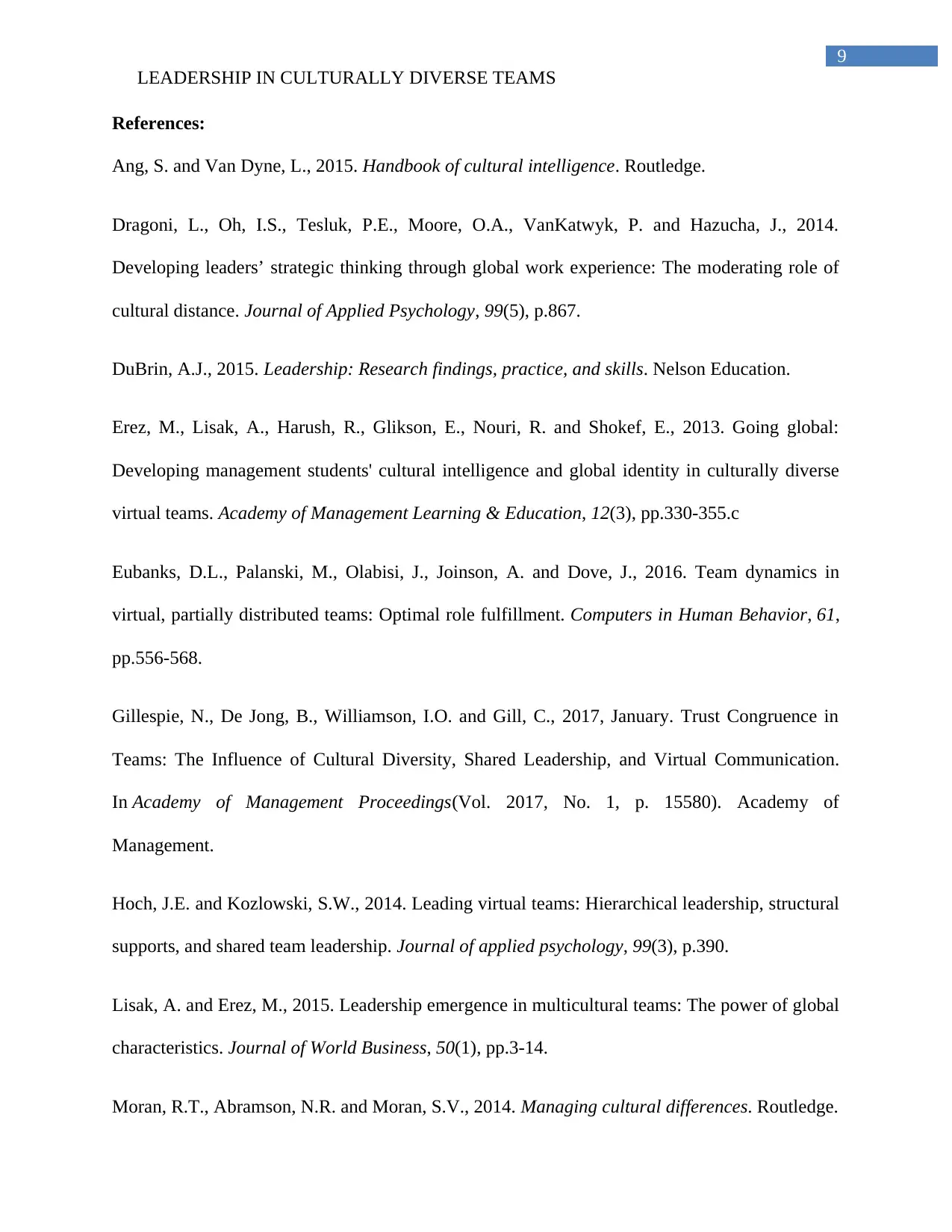
9
LEADERSHIP IN CULTURALLY DIVERSE TEAMS
References:
Ang, S. and Van Dyne, L., 2015. Handbook of cultural intelligence. Routledge.
Dragoni, L., Oh, I.S., Tesluk, P.E., Moore, O.A., VanKatwyk, P. and Hazucha, J., 2014.
Developing leaders’ strategic thinking through global work experience: The moderating role of
cultural distance. Journal of Applied Psychology, 99(5), p.867.
DuBrin, A.J., 2015. Leadership: Research findings, practice, and skills. Nelson Education.
Erez, M., Lisak, A., Harush, R., Glikson, E., Nouri, R. and Shokef, E., 2013. Going global:
Developing management students' cultural intelligence and global identity in culturally diverse
virtual teams. Academy of Management Learning & Education, 12(3), pp.330-355.c
Eubanks, D.L., Palanski, M., Olabisi, J., Joinson, A. and Dove, J., 2016. Team dynamics in
virtual, partially distributed teams: Optimal role fulfillment. Computers in Human Behavior, 61,
pp.556-568.
Gillespie, N., De Jong, B., Williamson, I.O. and Gill, C., 2017, January. Trust Congruence in
Teams: The Influence of Cultural Diversity, Shared Leadership, and Virtual Communication.
In Academy of Management Proceedings(Vol. 2017, No. 1, p. 15580). Academy of
Management.
Hoch, J.E. and Kozlowski, S.W., 2014. Leading virtual teams: Hierarchical leadership, structural
supports, and shared team leadership. Journal of applied psychology, 99(3), p.390.
Lisak, A. and Erez, M., 2015. Leadership emergence in multicultural teams: The power of global
characteristics. Journal of World Business, 50(1), pp.3-14.
Moran, R.T., Abramson, N.R. and Moran, S.V., 2014. Managing cultural differences. Routledge.
LEADERSHIP IN CULTURALLY DIVERSE TEAMS
References:
Ang, S. and Van Dyne, L., 2015. Handbook of cultural intelligence. Routledge.
Dragoni, L., Oh, I.S., Tesluk, P.E., Moore, O.A., VanKatwyk, P. and Hazucha, J., 2014.
Developing leaders’ strategic thinking through global work experience: The moderating role of
cultural distance. Journal of Applied Psychology, 99(5), p.867.
DuBrin, A.J., 2015. Leadership: Research findings, practice, and skills. Nelson Education.
Erez, M., Lisak, A., Harush, R., Glikson, E., Nouri, R. and Shokef, E., 2013. Going global:
Developing management students' cultural intelligence and global identity in culturally diverse
virtual teams. Academy of Management Learning & Education, 12(3), pp.330-355.c
Eubanks, D.L., Palanski, M., Olabisi, J., Joinson, A. and Dove, J., 2016. Team dynamics in
virtual, partially distributed teams: Optimal role fulfillment. Computers in Human Behavior, 61,
pp.556-568.
Gillespie, N., De Jong, B., Williamson, I.O. and Gill, C., 2017, January. Trust Congruence in
Teams: The Influence of Cultural Diversity, Shared Leadership, and Virtual Communication.
In Academy of Management Proceedings(Vol. 2017, No. 1, p. 15580). Academy of
Management.
Hoch, J.E. and Kozlowski, S.W., 2014. Leading virtual teams: Hierarchical leadership, structural
supports, and shared team leadership. Journal of applied psychology, 99(3), p.390.
Lisak, A. and Erez, M., 2015. Leadership emergence in multicultural teams: The power of global
characteristics. Journal of World Business, 50(1), pp.3-14.
Moran, R.T., Abramson, N.R. and Moran, S.V., 2014. Managing cultural differences. Routledge.
Paraphrase This Document
Need a fresh take? Get an instant paraphrase of this document with our AI Paraphraser
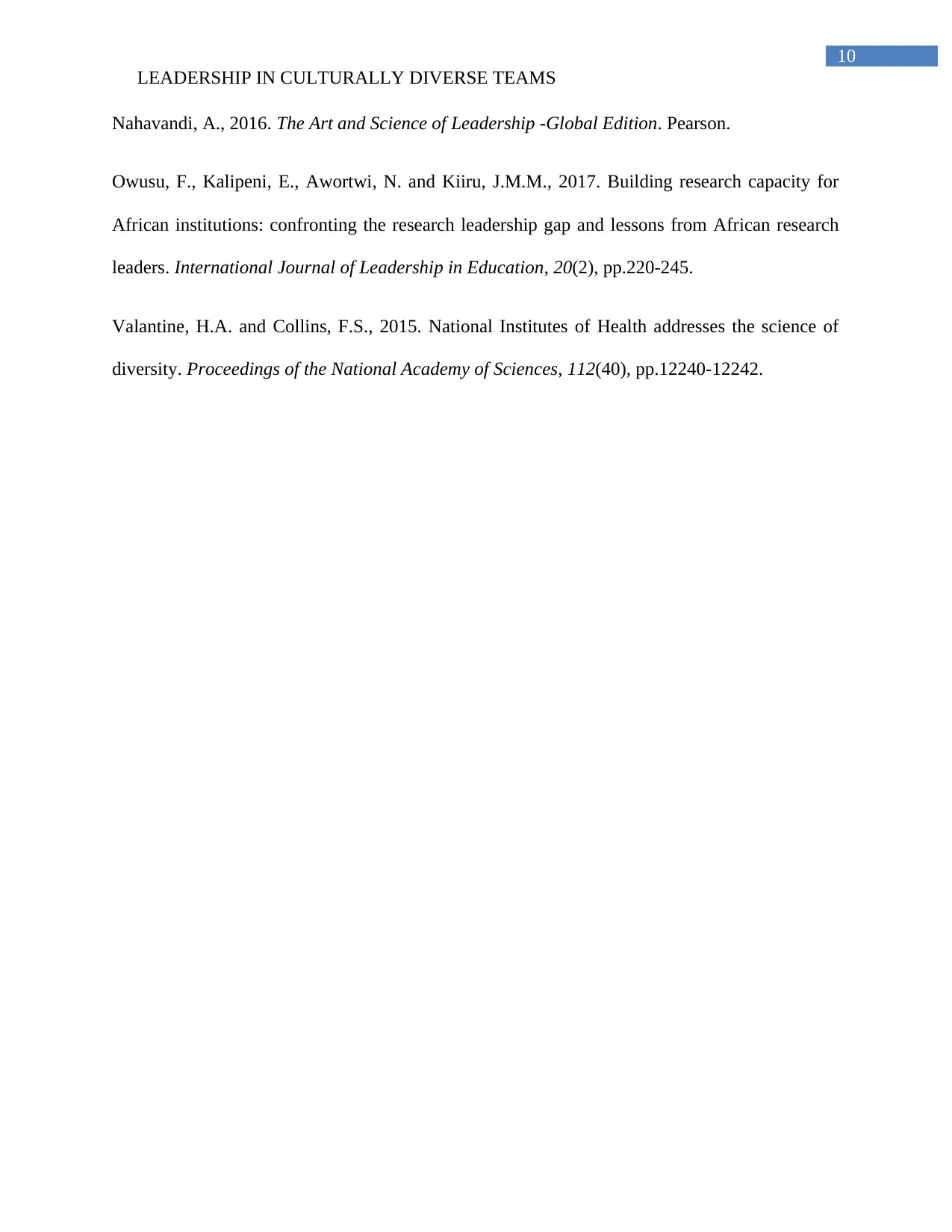
10
LEADERSHIP IN CULTURALLY DIVERSE TEAMS
Nahavandi, A., 2016. The Art and Science of Leadership -Global Edition. Pearson.
Owusu, F., Kalipeni, E., Awortwi, N. and Kiiru, J.M.M., 2017. Building research capacity for
African institutions: confronting the research leadership gap and lessons from African research
leaders. International Journal of Leadership in Education, 20(2), pp.220-245.
Valantine, H.A. and Collins, F.S., 2015. National Institutes of Health addresses the science of
diversity. Proceedings of the National Academy of Sciences, 112(40), pp.12240-12242.
LEADERSHIP IN CULTURALLY DIVERSE TEAMS
Nahavandi, A., 2016. The Art and Science of Leadership -Global Edition. Pearson.
Owusu, F., Kalipeni, E., Awortwi, N. and Kiiru, J.M.M., 2017. Building research capacity for
African institutions: confronting the research leadership gap and lessons from African research
leaders. International Journal of Leadership in Education, 20(2), pp.220-245.
Valantine, H.A. and Collins, F.S., 2015. National Institutes of Health addresses the science of
diversity. Proceedings of the National Academy of Sciences, 112(40), pp.12240-12242.
1 out of 11
Related Documents
Your All-in-One AI-Powered Toolkit for Academic Success.
+13062052269
info@desklib.com
Available 24*7 on WhatsApp / Email
![[object Object]](/_next/static/media/star-bottom.7253800d.svg)
Unlock your academic potential
Copyright © 2020–2025 A2Z Services. All Rights Reserved. Developed and managed by ZUCOL.





